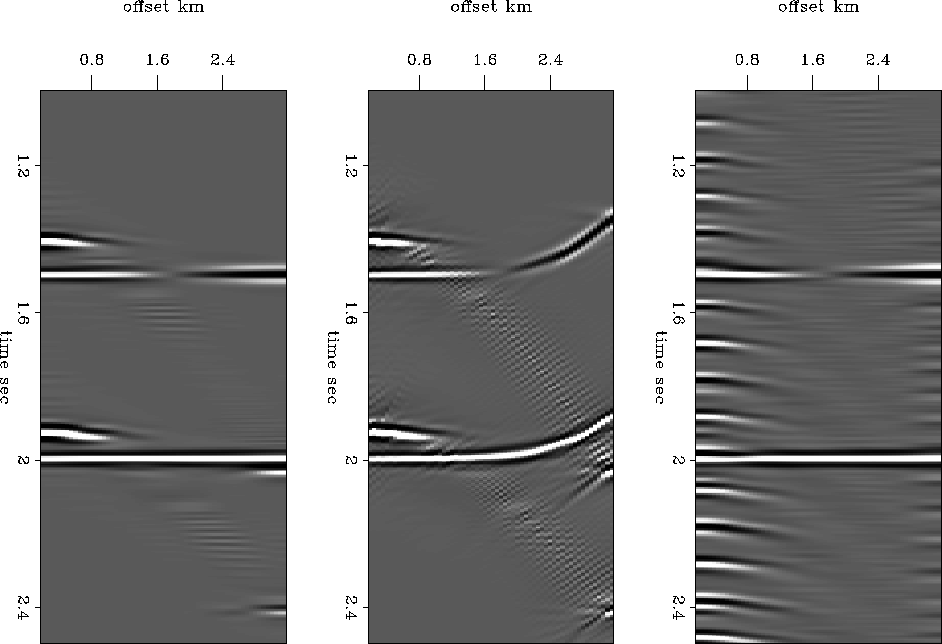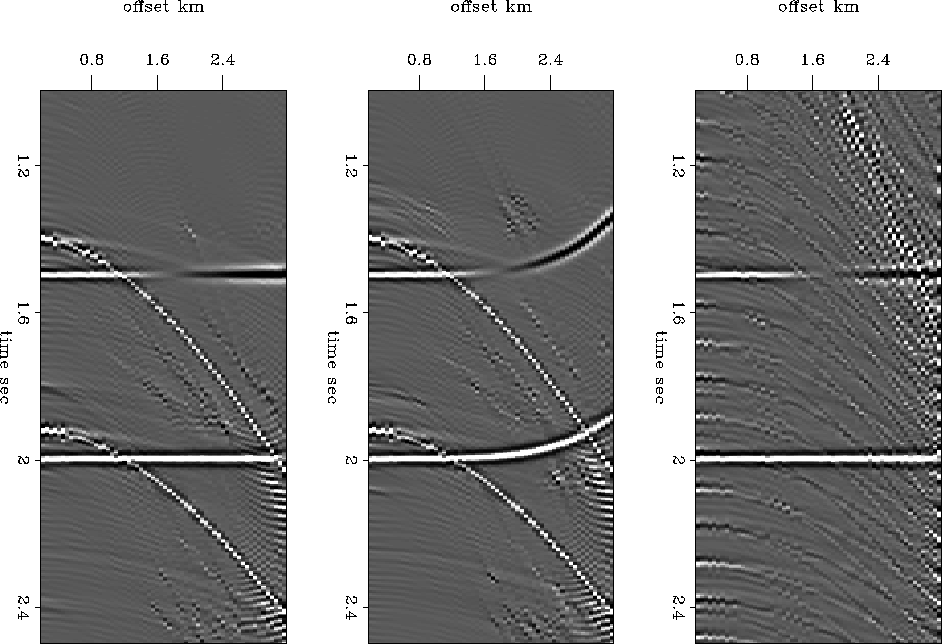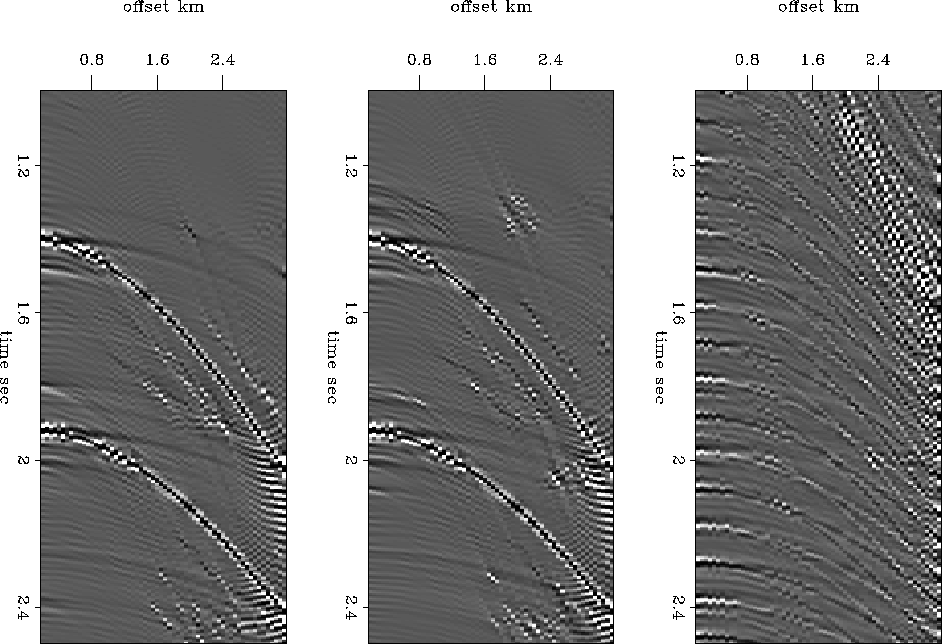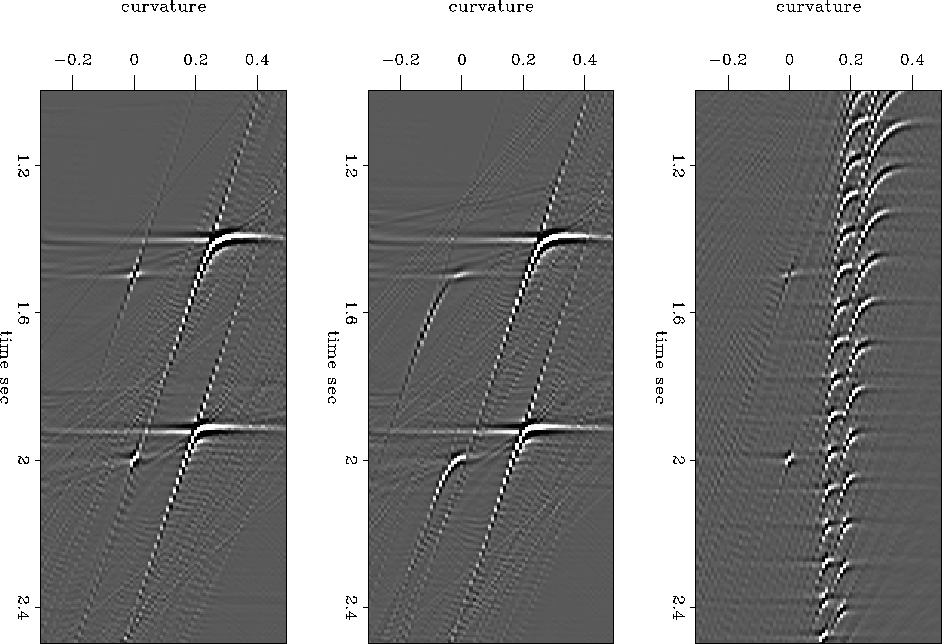




Next: Conclusion
Up: Holden: Multiple Suppression
Previous: Beam Stack Inversion
NMO correction makes separation of the multiple energy from primary
energy straightforward. Primary events in NMO-corrected gathers are
flat and map to the zero slowness, p=0s/km, slice of model space.
The energy in the rest of the model is multiple energy and can easily be
isolated by windowing out all slices with slowness greater than zero. This isolated multiple energy can be forward modeled and
subtracted from the original NMO-corrected data or the primary energy can be
forward modeled directly from the zero slowness slice. The NMO approach
avoids the somewhat difficult approach taken by
Holden and Biondi (1996) of applying a time-offset dependent mute to
inverted data without NMO correction. A potential drawback to the NMO approach
is that primary events in NMO-corrected gathers may not always
be flat. This may be compensated for if there is prior
knowledge of the primary event shape. In this respect the NMO method
may not be as robust as the method of applying a time-offset dependent mute to
inverted data without NMO correction
The multiple filtering results are displayed in figure
![[*]](http://sepwww.stanford.edu/latex2html/cross_ref_motif.gif) . These results were obtained by simply windowing the
zero slowness slice of each inversion result displayed in figures
. These results were obtained by simply windowing the
zero slowness slice of each inversion result displayed in figures
![[*]](http://sepwww.stanford.edu/latex2html/cross_ref_motif.gif) ,
,![[*]](http://sepwww.stanford.edu/latex2html/cross_ref_motif.gif) +
+ ![[*]](http://sepwww.stanford.edu/latex2html/cross_ref_motif.gif) ,
and then forward modeling. The windowing of the primary events in the
model2 case involved three slowness slices due to the negative dips
present on the primaries.
Like the primaries, the multiples will have a component of very
nearly zero slowness at the nearest offset. This energy will map into
the zero slowness panel with the primaries. This energy appears as stubs at
the near offsets of the results in figure
,
and then forward modeling. The windowing of the primary events in the
model2 case involved three slowness slices due to the negative dips
present on the primaries.
Like the primaries, the multiples will have a component of very
nearly zero slowness at the nearest offset. This energy will map into
the zero slowness panel with the primaries. This energy appears as stubs at
the near offsets of the results in figure ![[*]](http://sepwww.stanford.edu/latex2html/cross_ref_motif.gif) . The
reflecting boundary conditions contribute to the amplitude of these stubs.
. The
reflecting boundary conditions contribute to the amplitude of these stubs.
fwdprime
Figure 10 Result of beam stack multiple
suppression. Left: model1 estimated primaries, Center: model2
estimated primaries, Right: model3 estimated primaries.




 diffbs
diffbs
Figure 11 Energy difference of original
primaries and result of beam stack multiple suppression.




 prtprime
prtprime
Figure 12 Results of PRT multiple
suppression method. Left: model1 estimated primaries, Center: model2
estimated primaries, Right: model3 estimated primaries.




 diffprt
diffprt
Figure 13 Energy difference of original
primaries and result of PRT multiple suppression.




 prttrans
prttrans
Figure 14 PRT transform space. Left: model1,
Center: model2, Right: model3





I have prepared results of the PRT multiple suppression method as a
comparison. The estimated primaries of the NMO-corrected data using
the PRT multiple suppression method are displayed in figure
![[*]](http://sepwww.stanford.edu/latex2html/cross_ref_motif.gif) . The PRT transform of the NMO-corrected
data are displayed in figure
. The PRT transform of the NMO-corrected
data are displayed in figure ![[*]](http://sepwww.stanford.edu/latex2html/cross_ref_motif.gif) . Multiple energy
is obviously present in all three results in figure
. Multiple energy
is obviously present in all three results in figure
![[*]](http://sepwww.stanford.edu/latex2html/cross_ref_motif.gif) , the most notable cases are the distinct strong
multiple ghosts present with the
estimated primaries of model1 and model2. These ghosts are caused by the
inability of the PRT to compactly represent the significantly
non-parabolic multiples in PRT transform space such that the masking
procedure can not separate the primary from the multiple energy.
Examination of figure
, the most notable cases are the distinct strong
multiple ghosts present with the
estimated primaries of model1 and model2. These ghosts are caused by the
inability of the PRT to compactly represent the significantly
non-parabolic multiples in PRT transform space such that the masking
procedure can not separate the primary from the multiple energy.
Examination of figure ![[*]](http://sepwww.stanford.edu/latex2html/cross_ref_motif.gif) reveals that multiple energy
spreads over a large region of the PRT transform space and is probably
not properly isolated by the masking procedure associated with the PRT
method.
reveals that multiple energy
spreads over a large region of the PRT transform space and is probably
not properly isolated by the masking procedure associated with the PRT
method.
The difference between the estimated primaries from each method and the
original multiple-free primaries
appear in figure ![[*]](http://sepwww.stanford.edu/latex2html/cross_ref_motif.gif) for the beam stack method and
in figure
for the beam stack method and
in figure ![[*]](http://sepwww.stanford.edu/latex2html/cross_ref_motif.gif) for the PRT method.
The PRT method leaves a significant
amount of multiple energy in the multiple suppressed results for all
three cases at all times and offsets, where as the beam stack method
contains multiple energy only at the near offsets. Increasing the sampling of the
slowness parameter or range of the slowness parameters of the PRT
transform does not change the PRT result significantly.
for the PRT method.
The PRT method leaves a significant
amount of multiple energy in the multiple suppressed results for all
three cases at all times and offsets, where as the beam stack method
contains multiple energy only at the near offsets. Increasing the sampling of the
slowness parameter or range of the slowness parameters of the PRT
transform does not change the PRT result significantly.





Next: Conclusion
Up: Holden: Multiple Suppression
Previous: Beam Stack Inversion
Stanford Exploration Project
11/11/1997
![[*]](http://sepwww.stanford.edu/latex2html/cross_ref_motif.gif) . These results were obtained by simply windowing the
zero slowness slice of each inversion result displayed in figures
. These results were obtained by simply windowing the
zero slowness slice of each inversion result displayed in figures
![[*]](http://sepwww.stanford.edu/latex2html/cross_ref_motif.gif) ,
,![[*]](http://sepwww.stanford.edu/latex2html/cross_ref_motif.gif) +
+ ![[*]](http://sepwww.stanford.edu/latex2html/cross_ref_motif.gif) ,
and then forward modeling. The windowing of the primary events in the
model2 case involved three slowness slices due to the negative dips
present on the primaries.
Like the primaries, the multiples will have a component of very
nearly zero slowness at the nearest offset. This energy will map into
the zero slowness panel with the primaries. This energy appears as stubs at
the near offsets of the results in figure
,
and then forward modeling. The windowing of the primary events in the
model2 case involved three slowness slices due to the negative dips
present on the primaries.
Like the primaries, the multiples will have a component of very
nearly zero slowness at the nearest offset. This energy will map into
the zero slowness panel with the primaries. This energy appears as stubs at
the near offsets of the results in figure ![[*]](http://sepwww.stanford.edu/latex2html/cross_ref_motif.gif) . The
reflecting boundary conditions contribute to the amplitude of these stubs.
. The
reflecting boundary conditions contribute to the amplitude of these stubs.




